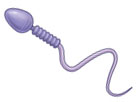Testosterone Test
A testosterone test checks the level of this male hormone (androgen) in the blood. Testosterone affects sexual features and development. In men, it is made in large amounts by the testicles. In both men and women, testosterone is made in small amounts by the adrenal glands, and in women, by the ovaries.
The pituitary gland controls the level of testosterone in the body. When the testosterone level is low, the pituitary gland releases a hormone called luteinizing hormone (LH). This hormone tells the testicles to make more testosterone.
Before puberty, the testosterone level in boys is normally low. Testosterone increases during puberty. This causes boys to develop a deeper voice, get bigger muscles, make sperm, and get facial and body hair. The level of testosterone starts to decline around age 40, then gradually becomes less in older men.
In women, the ovaries account for half of the testosterone in the body. Women have a much smaller amount of testosterone in their bodies compared to men. But testosterone plays an important role throughout the body in both men and women. It affects the brain, bone and muscle mass, fat distribution, the vascular system, energy levels, genital tissues, and sexual functioning.
Most of the testosterone in the blood is bound to a protein called sex hormone binding globulin (SHBG). Testosterone that is not bound ("free" testosterone) may be checked if a man or a woman is having sexual problems. Free testosterone also may be tested for a person who has a condition that can change SHBG levels, such as hyperthyroidism or some types of kidney diseases.
Total testosterone levels vary throughout the day. They are usually highest in the morning and lowest in the evening.
Why It Is Done
A testosterone test may be done to:
- See why a man is having problems in fathering a child (infertility). A low amount of testosterone can lead to low sperm counts.
- Check a man's sexual problems. Having a low level of testosterone may lower a man's sex drive or not allow him to have an erection (erectile dysfunction).
- See whether a high level of testosterone is causing a boy younger than age 10 to have early signs of puberty.
- Find out why a woman is developing male features, such as excessive facial and body hair (hirsutism) and a deep voice.
- Find out why a woman is having irregular menstrual periods.
- See if testosterone-lowering medicines are working in a man with advanced prostate cancer.
- Find the cause of osteoporosis in a man.
How To Prepare
In general, there's nothing you have to do before this test, unless your doctor tells you to. Your doctor may want you to do a morning blood test. That's because testosterone levels are highest between 7 a.m. and 9 a.m.
How It Is Done
A health professional uses a needle to take a blood sample, usually from the arm.
How It Feels
When a blood sample is taken, you may feel nothing at all from the needle. Or you might feel a quick sting or pinch.
Risks
There is very little chance of having a problem from this test. When a blood sample is taken, a small bruise may form at the site.
Results
Your doctor will have your test results in a few days.
Normal
Each lab has a different range for what's normal. Your lab report should show the range that your lab uses for each test. The normal range is just a guide. Your doctor will also look at your results based on your age, health, and other factors. A value that isn't in the normal range may still be normal for you.
High values
- In men, a high level of testosterone may be caused by cancer of the testicles or adrenal glands.
- In boys younger than 10, a high level of testosterone may mean early (precocious) puberty, a tumor in the testicles, or an abnormal adrenal gland.
- In women, a high level of testosterone may be caused by cancer of the ovaries or adrenal glands or by polycystic ovary syndrome (PCOS). In rare cases, the part of the ovary that makes testosterone can become very sensitive to luteinizing hormone (LH), causing very high testosterone levels. This condition is called hyperthecosis.
Low values
- In men or boys who have gone through puberty, a low level of testosterone may be caused by a problem with the testicles, such as slow development of, an injury to, or a lack of testicles. It can also be caused from treatment with the female hormone estrogen, a problem with the pituitary gland, or many long-term (chronic) illnesses.
- A low testosterone level in men can also be caused by certain inherited diseases (such as Klinefelter syndrome or Down syndrome), liver disease (cirrhosis), or treatment for cancer of the prostate gland.
- Long-term (chronic) alcohol use can cause a low testosterone level.
- Addison's disease can cause a low level of testosterone.
- In women, a low level of testosterone may be caused by an underactive pituitary gland, loss of ovary function through disease or surgery, and some medicines (such as corticosteroids or estrogen).
- Being very overweight, having long-term (chronic) pain, or taking some pain medicines can lower the level of sex hormone binding globulin (SHBG). This also decreases total testosterone level.
Related Information
Credits
Current as of: July 7, 2025
Author: Ignite Healthwise, LLC Staff
Clinical Review Board
All Ignite Healthwise, LLC education is reviewed by a team that includes physicians, nurses, advanced practitioners, registered dieticians, and other healthcare professionals.
Current as of: July 7, 2025
Author: Ignite Healthwise, LLC Staff
Clinical Review Board
All Ignite Healthwise, LLC education is reviewed by a team that includes physicians, nurses, advanced practitioners, registered dieticians, and other healthcare professionals.







